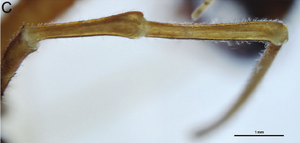| Forsteropsalis bona | |
|---|---|
 Forsteropsalis bona Taylor & Probert, 2014 Dorsal view (from original description) | |
|
Suborder |
|
|
Superfamily |
|
|
Family |
|
|
Subfamily |
|
|
Genus |
|
Forsteropsalis bona Taylor & Probert, 2014 is a member of the genus Forsteropsalis (Eupnoi:Neopilionidae).
Taxonomy
- F.b. Taylor & Probert, 2014:39[1]
Specimens
- F.b. male(1) (holotype) Museum of New Zealand Te Papa Tongarewa, Wellington, New Zealand; #[1]
- F.b. male(2) (paratypes) Museum of New Zealand Te Papa Tongarewa, Wellington, New Zealand; #[1]
- F.b. male(1) (paratype) New Zealand Arthropod Collection, Landcare Research, Auckland, New Zealand; #[1]
Diagnosis
(from Taylor & Probert, 2014[1])
- Total body length 4.8–6.6; prosoma length 2.5–2.8, width 4.0–4.2. Prosoma (including ocularium) unarmed (Fig. 1A); ground colour in alcohol orangebrown with longitudinal yellow stripes on either side of ocularium (live coloration very dark brown [almost black] with orange-yellow stripes; appendages also black). Ozopores elongate, with small flanking lobes. Opisthosoma grey-yellow. Mouthparts cream-coloured; medial side of pedipalpal coxa with dense array of sharp denticles; cervix unarmed. Coxae yellow.
- Chelicerae (Fig. 1B): Segment I length 6.2–8.4; segment II 9.4–10.4. Elongate; segment I orange with lighter yellow patch at distal end, segment II dark orange-brown. Segment I denticulate, with denticles concentrated along dorsal, proventral and retroventral margins. Segment II massively inflated, evenly denticulate. Cheliceral fingers elongate, widely bowed apart; setae present on distal half of mobile finger.
- Pedipalps: Femur length 5.4–5.7; patella 2.2–2.4; tibia 2.8–3.1; tarsus 5.8–6.5. Distinctly elongate, yellow. Femur dorsally denticulate on proximal two-thirds; remainder of pedipalp unarmed. Setae sparse except for small concentration at prodistal end of patella; microtrichia present on tarsus and distal half of tibia; prodorsal end of patella with distinct protrusion but without definite finger-like apophysis (Fig. 1C). Tarsal claw without ventral tooth-row.
- Legs: Legs I femur length 8.6–9.9, patella 1.9–2.5, tibia 8.3–9.8; leg II femur 14.3–17.2, patella 2.2–2.8, tibia 14.4–17.8; leg III femur 7.5–8.7, patella 1.7–2.3, tibia 5.3–8.2; leg IV femur 8.5–10.7, patella 1.8–2.7, tibia 10.2–10.8. Femora sparsely denticulate, particularly in proximal half; remainder of legs unarmed. Distitarsus I with strong ventral tooth at distal end of each of first five or six pseudosegments (Fig. 1D). Tibia II with nine to fifteen pseudosegments; tibia IV with two pseudosegments.
- Penis (Fig. 1E–F): Shaft subquadrate; tendon long. Bristle groups relatively long, posterior bristle group with longest bristles reaching dorsal margin in lateral view. Glans short, subtriangular in ventral view, narrowing rapidly in lateral view.
Notes
Literature
- Taylor & Probert, 2014[1]
Additional images - Gallery
Proximal pseudosegments of right distitarsus I (venter upwards), showing ventrodistal teeth (from original description)





